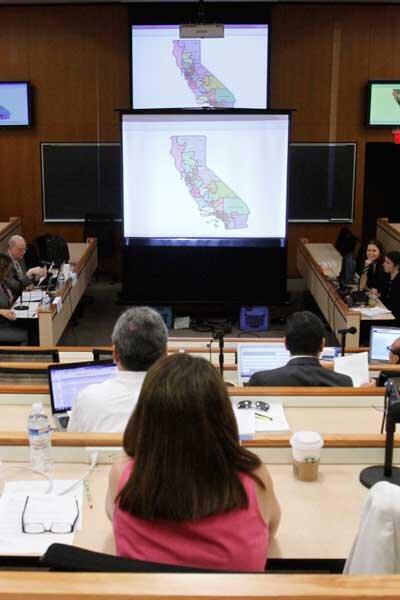Did California just take a big step toward political sanity?
| Los Angeles
California's attempts to overcome a decade of political dysfunction took another step Friday, when the final version of newly redrawn legislative and congressional districts were released to the public.
Political experts have long blamed a significant part of the political gridlock in California on the partisan way that legislative districts were drawn. With most districts either strongly Democratic or strongly Republican, legislators were encouraged to play their party's extremes to be reelected.
The Citizen Redistricting Commission that spent seven months drawing the new maps has gone some way toward solving that problem, political experts say. Though the maps may slightly help Democrats – perhaps even giving them enough seats to claim supermajorities in both houses of the Legislature – the new districts are more competitive than the current ones.
“I can’t see a partisan agenda in these maps if there is one,” says Eric McGhee, a redistricting expert at the Public Policy Institute of California (PPIC).
The greater complaint is likely to come from ethnic groups, particularly Hispanics, which suggest the new districts diminish their political clout by diluting their numbers. There will actually be fewer Latino-heavy districts under the new plan than there are now – despite the fact that Latinos have accounted for 90 percent of the state's population growth during the past decade, says Arturo Vargas, executive director of the National Association of Latino Elected and Appointed Officials.
"The draft maps will make it harder for Latino voices to be heard in California politics in proportion to their numbers,” he says, adding that his organization could consider litigation under the Voting Rights Act of 1965, which outlaws discriminatory voting practices.
The 14-member commission – five Democrats, five Republicans, and four decline-to-states – was created by a 2008 ballot initiative, Proposition 11, which deprived state legislators of authority to draw their own political districts. In 2011, Proposition 20 expanded the commission's authority to include redrawing congressional districts, too.
The process now moves to two weeks of public comment before a final vote, which will pave the way for the maps' use in next year’s statewide elections. By federal law, congressional apportionment needs to be recalculated every 10 years according to new US Census figures.
The reviews are mostly positive.
“They conducted themselves with honor and integrity and people are uniformly impressed,” says Zabrae Valentine, deputy director of California Forward, a nonpartisan public interest reform group. She and others say that although the outcome is not perfect, it is a huge improvement.
“This is the first time we’ve tried a major new policy like this, so it’s important not to compare it to perfection but rather the alternative. Remember, legislators did it behind closed doors,” says Ms. Valentine. “This commission let in the sunlight so that everyone could be a part of the conversation, and though not everyone will be happy – nor can they all be – the result will be a much more accountable, responsible government.”
Politically, the maps would seem to favor the Democrats. Currently, 53 state Assembly seats are “Democrat leaning,” says Mr. McGhee of PPIC. The new figure will be 54. On the Senate side, 28 Democrat-leaning districts will be bumped to 29. And congressionally, 33 Democrat-leaning seats will jump to 39.
That small bump might be enough to give Democrats a two-thirds majority in the state Legislature – a critical threshold because that is the majority needed for tax increases. But such an outcome is by no means a given.
“More competitive districts just means the outcome is more uncertain,” says McGhee. “Even though the potential has improved for Democrats, they still have to convince voters.”
Ethnic activists' opinions were more mixed.
Eugene Lee, voting rights project director for the Asian Pacific American Legal Center, says the process should give other states caution.
“There are tradeoffs. This increased transparency helps give voters confidence in the system, but these were just regular citizens with no experience in redistricting at all,” says Mr. Lee. He said one misstep occurred when the commission announced that a public comment period would ensue after a second draft map, and subsequently canceled hearings. “A lot depends on exactly who you have as commissioners,” he says.
Meanwhile, Najee Ali, a leading black activist in Los Angeles, called the current maps a victory for the African-American community in California.
“We can breathe a sigh of relief that so far, we have staved off political extinction in this state as we continue to be outpaced by the surging Latino population,” says Mr. Ali, director of Project Islamic H.O.P.E.
At the meeting Friday, there was division among the commissioners, as well, though the maps passed, 12 to 2.
One Republican commissioner, Michael Ward, agreed with the praise of the process but disagreed with its ultimate outcome.
“After much deliberation, and quite frankly, anguish, I am sad to find myself compelled to vote 'no' on the fruits of our labor.” He said the commission bowed to racial and community-of-interest considerations to the detriment of other criteria, such as showing respect for city and county boundaries and drawing boundaries that are compact and contiguous.
But others congratulated themselves for a challenging job well done.
“Change in the status quo is hard,” said commissioner Stan Forbes, noting months of struggle, getting input from citizens via e-mail, phone, fax, and hearings. “But we have done a great job with well in excess of 20,000 Californians participating. This is the best in democracy that this state has seen in a long time.”





